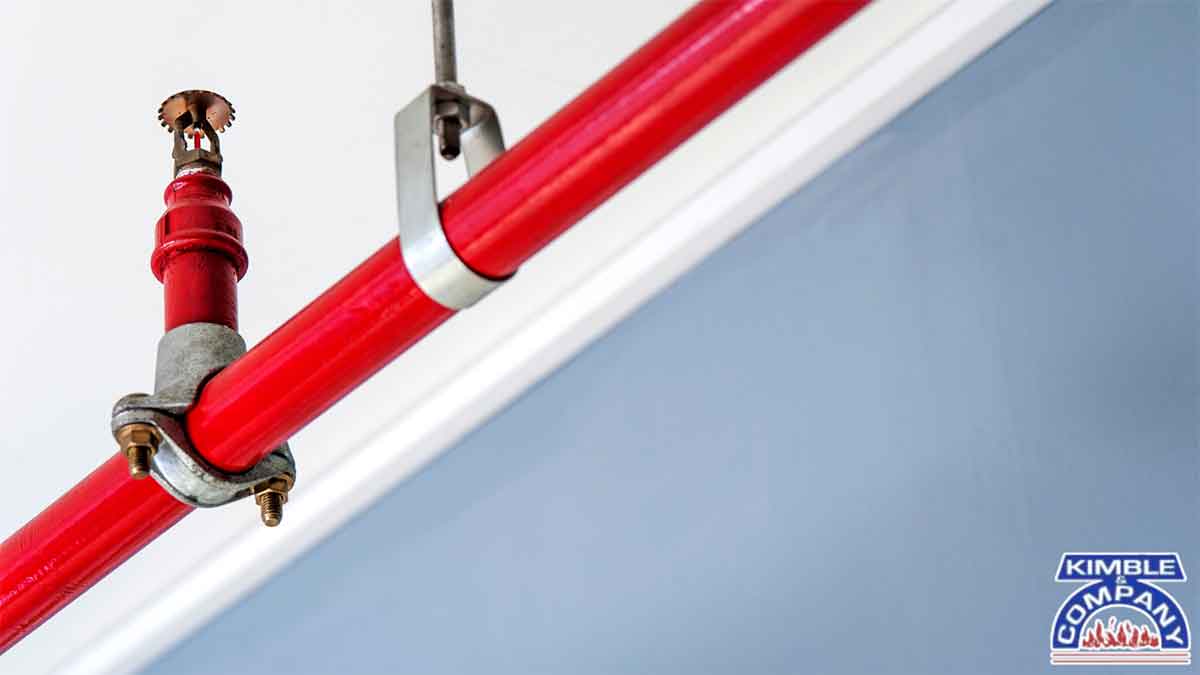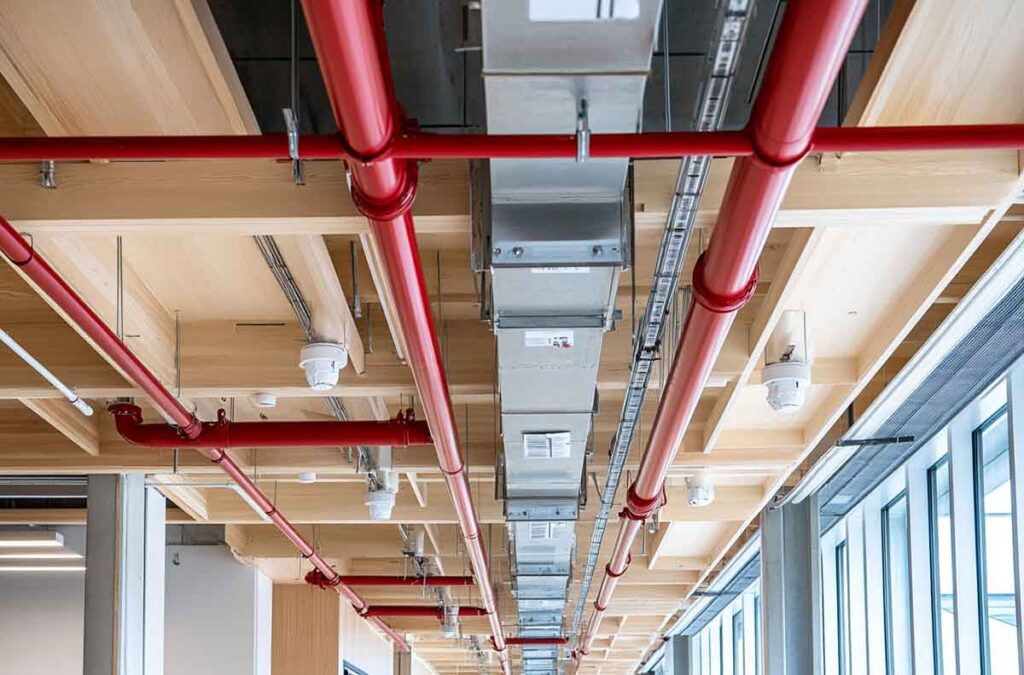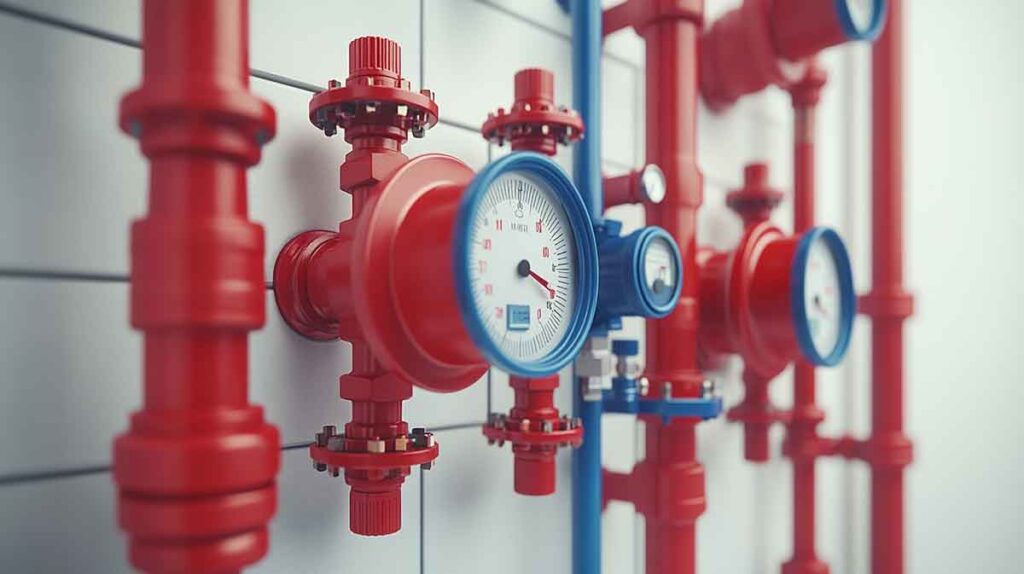There is no room for guesswork in fire safety. If you are installing a fire sprinkler system, every step matters. From engineering to inspection, each phase must be executed with precision. Delays, violations, or overlooked details can cost more than time. They can compromise both compliance and safety. This step-by-step guide outlines the installation process so you know exactly what needs to happen, when, and why it is essential. There will be no surprises, no confusion, just clarity and control from start to finish.
Understanding the Full Installation Process
Installing a fire sprinkler system is not a routine upgrade. It is a precision-driven process that blends technical design, regulatory knowledge, and physical execution. Every detail must be right—from the first pipe to the final test—because there is no second chance when these systems are called into action. Below is a full breakdown of what goes into a properly designed and installed fire sprinkler system.
How do sprinkler systems work step by step?
Fire sprinklers are heat-activated devices designed to suppress fires at their origin. Each sprinkler head contains a heat-sensitive element that responds to rising temperatures, typically around 155°F. Once triggered, the head opens and releases water in a targeted spray pattern to control the fire in that specific area.
Only the sprinkler heads exposed to the high heat will activate. This design prevents unnecessary water damage in unaffected areas. The system relies on a reliable and pressurized water source from a municipal line, on-site water tank, or fire pump. Pipes run throughout the ceiling and walls, strategically positioned to give complete coverage across every zone of the property.
How is a fire sprinkler system installed?
The installation begins with a detailed layout based on the building’s occupancy, square footage, and code requirements. This engineered design maps head spacing, pipe routing, and hydraulic demands.
Installation crews follow this plan to:
- Secure piping networks through ceilings, joists, or walls
- Position sprinkler heads precisely in each designated zone
- Connect the system to the water supply
- Integrate with a fire alarm system if required
Once installed, the system is pressurized and flushed to eliminate debris. This is followed by a hydrostatic test to confirm leak-free performance. The system moves forward for final inspection and approval only after passing this test.
Pre-Installation Planning and Site Assessment
No fire sprinkler system should begin with guesswork. The success of any installation starts well before a single pipe is laid. Strategy, safety, and code compliance converge in this planning stage. This phase is the foundation of a code-compliant and fully functional fire protection system, from evaluating the structure to aligning system specifications with building requirements.
How do you design a fire sprinkler system step by step?
Designing a fire sprinkler system is a calculated process that requires more than just technical knowledge. It demands a complete understanding of building construction, fire behavior, code compliance, and hydraulic performance. The goal is to create a system that activates efficiently, delivers adequate water flow, and covers every risk zone within the structure.
The process begins with a site survey and risk assessment. Certified engineers evaluate critical elements such as:
- Building size, shape, and occupancy classification
- Fire hazard levels based on contents and operational use
- Ceiling height, slope, and obstructions that may affect spray patterns
- Existing infrastructure, including available water pressure and supply sources
Once the risk profile is established, the design team calculates the system demand. This includes determining:
- Required sprinkler head types (pendent, upright, sidewall, etc.)
- Head spacing and density based on hazard classification (light, ordinary, or extra hazard)
- Pipe sizing and material selection (steel, CPVC, or copper)
- System type: wet, dry, pre-action, or deluge
- Flow requirements and pressure calculations using hydraulic modeling
Advanced design tools such as HydraCAD or BIM software are used to draft precise layouts that meet NFPA 13 standards and local building codes. These digital designs are reviewed and submitted for approval to the Authority Having Jurisdiction (AHJ) before procurement and installation.
How do you install a sprinkler system step by step?
Once the design has been reviewed and approved, the installation team proceeds with a carefully sequenced process. This stage transforms engineering plans into a fully operational life safety system. Precision and coordination are key to ensuring that each system component performs as intended under fire conditions.
Here is the typical step-by-step process:
- Site Verification and Marking
Technicians begin with a full walkthrough to verify that field conditions match design specs. Pipe routes, sprinkler head placements, and ceiling obstructions are marked for reference. - Mounting Pipe Supports and Hangers
Structural elements are secured to support piping. Proper spacing and anchoring are critical to maintaining integrity under pressurized flow and meeting seismic bracing requirements. - Piping Installation
Installers begin with the main supply lines, then branch out to lateral piping leading to each sprinkler head. All pipe joints are sealed and torqued according to manufacturer and code requirements. - Sprinkler Head Attachment
Each head is installed with exact orientation, elevation, and spacing. This step ensures coverage patterns meet design intent and avoid dead zones or obstructions. - System Testing and Flushing
Once the full network is assembled, it undergoes a hydrostatic pressure test to detect leaks. A system flush is also performed to remove debris or sediment that may have entered during installation. - Integration with Alarm or Monitoring Systems
If required, flow switches, tamper switches, and alarm valves are connected to the building’s fire alarm system to trigger alerts in case of activation. - Final Documentation and Inspection Preparation
As-built drawings, test results, material certifications, and maintenance guidelines are compiled for submission to the local fire marshal or building department. The system is now ready for official inspection.
Each phase must comply with NFPA 13, California Title 19, and any jurisdictional requirements specific to the Los Angeles area. Skipping even a single detail can compromise system performance or delay approval.
Permits, Codes, and Local Compliance
No system can be installed without first meeting code requirements. This section is where compliance takes center stage. Authorities won’t approve your project unless every detail aligns with national standards and local ordinances.
What regulations apply to LA property managers?
Los Angeles enforces fire protection regulations through NFPA 13 (for system design), Title 19 of the California Code of Regulations, and the Los Angeles Fire Department’s Reg 4 testing standards. Commercial properties must submit fire sprinkler plans to the city for review and secure permits before installation begins.
The Reg 4 program also requires specific performance testing for systems like sprinklers, standpipes, and alarms. Most tests must be performed annually by certified professionals.
Who can perform these inspections?
Only individuals or firms certified under Reg 4 and qualified to conduct fire protection services can legally inspect and certify fire sprinkler systems in Los Angeles. Technicians are typically NICET-certified and trained in installation and ongoing maintenance compliance testing. Hiring the right professionals ensures the work is not only code-compliant but also accepted by the Authority Having Jurisdiction (AHJ).
Installation Phase: Timeline and Key Milestones
This is the turning point where engineering plans become real-world protection. With permits approved and designs finalized, the fire sprinkler installation moves into full execution mode. Timelines are tight, and success depends on coordination across trades, accurate implementation, and clean inspection milestones. Every step must be completed correctly to keep the project and building compliant.
What are the key steps in a fire inspection?
After installing the sprinkler system, several critical inspections are required before it is deemed functional and safe. These inspections verify the system’s integrity, ensure code compliance, and confirm that all components were installed according to plan.
Inspectors typically check for:
- Proper placement and alignment of sprinkler heads
- Correct pipe routing and support bracketing
- Hydrostatic pressure testing to confirm leak-free operation
- Functional integration with the fire alarm system, if applicable
- Correct valve labeling and visibility of all control components
- Valid documentation, including approved plans and product certifications
A final walkthrough with the local fire marshal or AHJ ensures nothing is missed. This review is not just a formality. It is required before a Certificate of Occupancy can be issued or before the space is considered legally protected.
How do I prepare my building for an inspection?
Inspection success starts long before an inspector arrives. The goal is to eliminate surprises and ensure the system, building access, and paperwork are all ready for immediate review. Poor preparation can lead to failed inspections, rework, and costly delays.
Before the scheduled inspection, make sure:
- Every sprinkler head is free from obstruction and correctly aligned
- Riser rooms, control valves, and test drains are accessible and unlocked
- All system components match the approved design and permitted layout
- Documentation is organized and available, including stamped plans, pressure test results, manufacturer data sheets, and permit
If the system is integrated with a fire alarm system, schedule a technician to verify device communication and test signal outputs during inspection. This shows diligence and helps streamline the approval process.
Preparation here is not just about passing the test. It demonstrates a commitment to life safety and sets the tone for long-term system performance.
Post-Installation Testing and Final Approvals
Once installation is complete, the job is not over. In the final stage, your fire sprinkler system proves itself in function and documentation. This phase ensures that the system operates as designed, meets all code requirements, and is officially cleared for occupancy. Skipping steps at this point can compromise safety and delay full compliance.
What documents are needed for fire inspections?
Inspectors and code officials expect complete and well-organized documentation. Having these materials ready can speed up the approval process and prevent unnecessary delays.
Be prepared to provide:
- Final as-built system drawings that reflect the installed layout
- Hydrostatic testing and system flushing reports
- Material and manufacturer certifications for system components
- Signed permits, plan approvals, and prior inspection records
These records are required for sign-off and support long-term compliance. Maintaining accurate documentation ensures your fire protection system remains in good standing during audits, renewals, or insurance claims.
Are there penalties for not conducting inspections?
Yes. Failing to conduct required annual inspections puts your property legally and operationally at risk. Ignoring inspection schedules can lead to immediate consequences and long-term liability.
Common penalties include:
- Fines or citations issued by local fire departments
- Delays in receiving occupancy permits or project approvals
- Insurance complications or denied claims in the event of a fire
A neglected inspection schedule can also result in a system failure when it is needed most. Annual fire sprinkler inspections are a core part of responsible fire protection. They verify that your system remains operational and code-compliant year after year.
Stay Protected with a System That Works
A fire sprinkler system is only as good as the team behind it. From layout and permitting to pressure tests and final sign-off, every step must be done right to ensure lasting protection and full code compliance. When your system is properly designed, installed, and tested, it works exactly when you need it—without fail.
If you’re ready to install with confidence, now is the time to act. Choose a team that delivers custom layouts, certified design, expert installation, and thorough inspections that pass the first time.
Call Kimble & Company Fire Protection Systems at (714) 894-7310 or request a quote today. Get fire protection done right from start to finish—with no shortcuts, surprises, or missed deadlines. Let’s protect what matters most.



